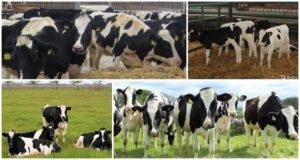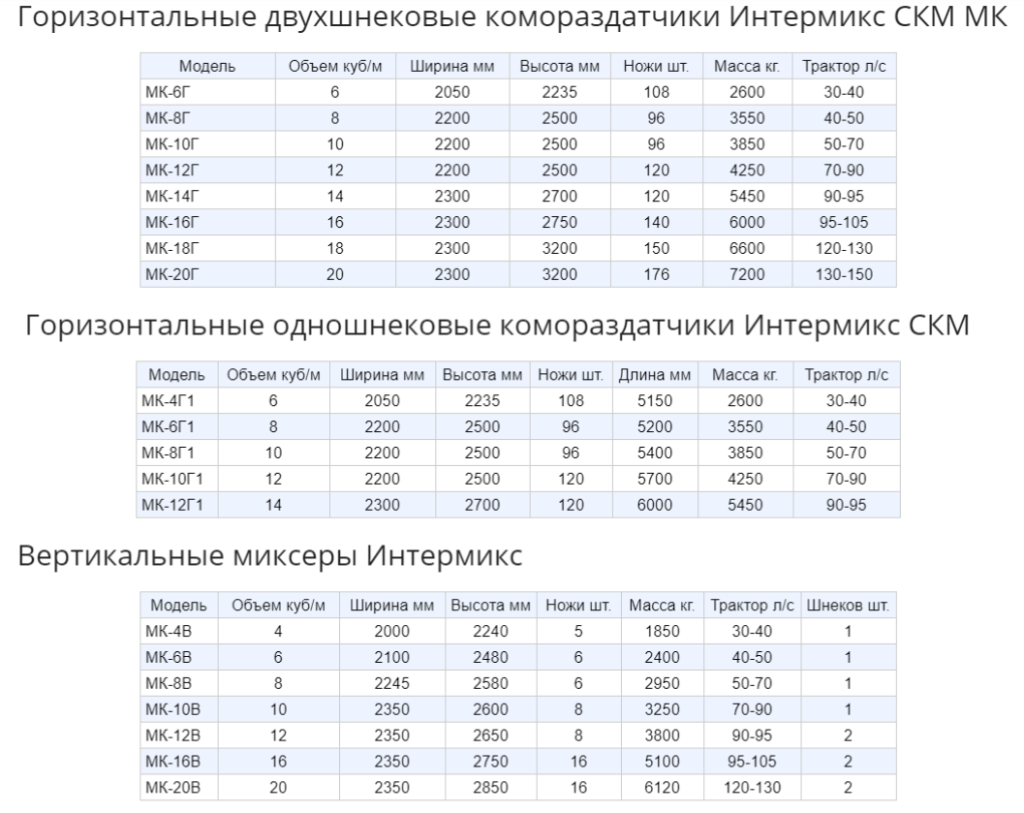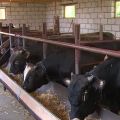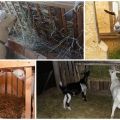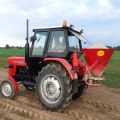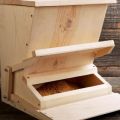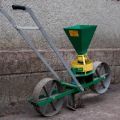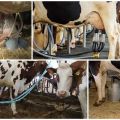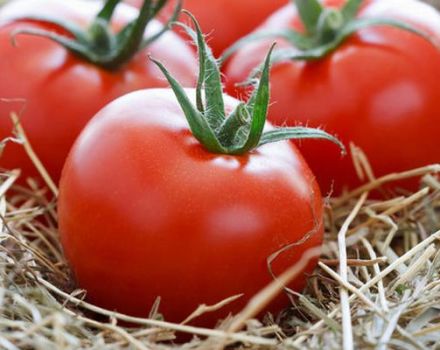Varieties of feed dispensers for cattle and rules for their use on farms
The modern cattle farm feed dispenser is a functional technique that reduces labor costs and saves feed for livestock. The equipment is aimed at the correct and even distribution of mixtures in accordance with zootechnical norms and requirements. The unit crushes, mixes feed. There is stationary and mobile equipment.
Purpose and principle of operation of the mechanism
The dispenser is intended not only for distributing food to livestock, but also for receiving, delivering, mixing ingredients in a given ratio. They are effective for dry, succulent and liquid feed.
The technical device distributes the feed mixture in a metered manner across the feeders, moving along the rows and unloading on both sides. A number of requirements are put forward for automated feed dispensers:
- keeping feed in a pure form;
- strict dose accounting;
- feeding at a certain time;
- exact proportions and homogeneity after mixing;
- safety for livestock and employees.
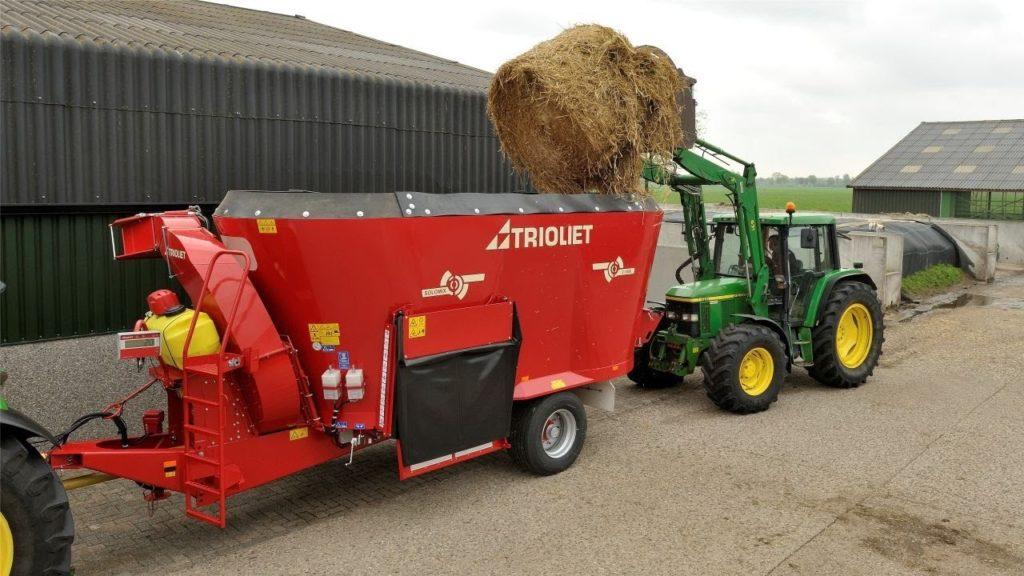
The feed is loaded in bales into the hopper of the mobile distributor, where the process of crushing and mixing takes place A similar mechanism is necessary for a large farm. For small farms, stationary devices are used, for larger ones, mobile ones.
The principle of operation and maintenance of equipment is not difficult. Feed is loaded into a special container, in strict accordance with the norm. This is possible with dispensers. Then the resulting mixture goes to the conveyor or directly to the feeders. The conveyor is looped, so the dispensing is over as soon as the first scraper picks up the mixture and makes a revolution in a circle. The drive then shuts off automatically.
Advantages and disadvantages of using
The main advantages of mechanical distributors are that with their help the farmer controls the feed consumption. A similar mechanism allows you to increase the income of the enterprise, reducing maintenance costs. Other advantages of the mechanism are as follows:
- temperature control of the supplied feed and mixtures;
- transportation of feed mixtures and loading into feeders;
- grinding, homogeneous mixing and other types of feed preparation before serving;
- self-loading with a mobile bucket;
- electronic weighing, accurate dosing of the supplied food.
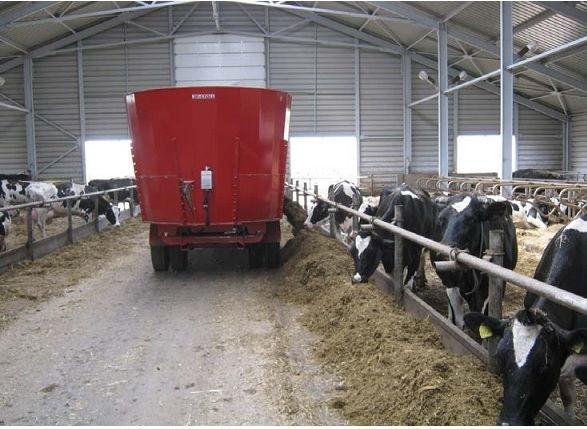
Thus, automatic feed dispensers significantly reduce the cost of production and facilitate working conditions.
There are no flaws in the units, however, individual models may not meet the farmer's expectations as each has different specifications and capabilities. Before choosing a mechanism, you should familiarize yourself with the types and classification of equipment.
Feeder classification
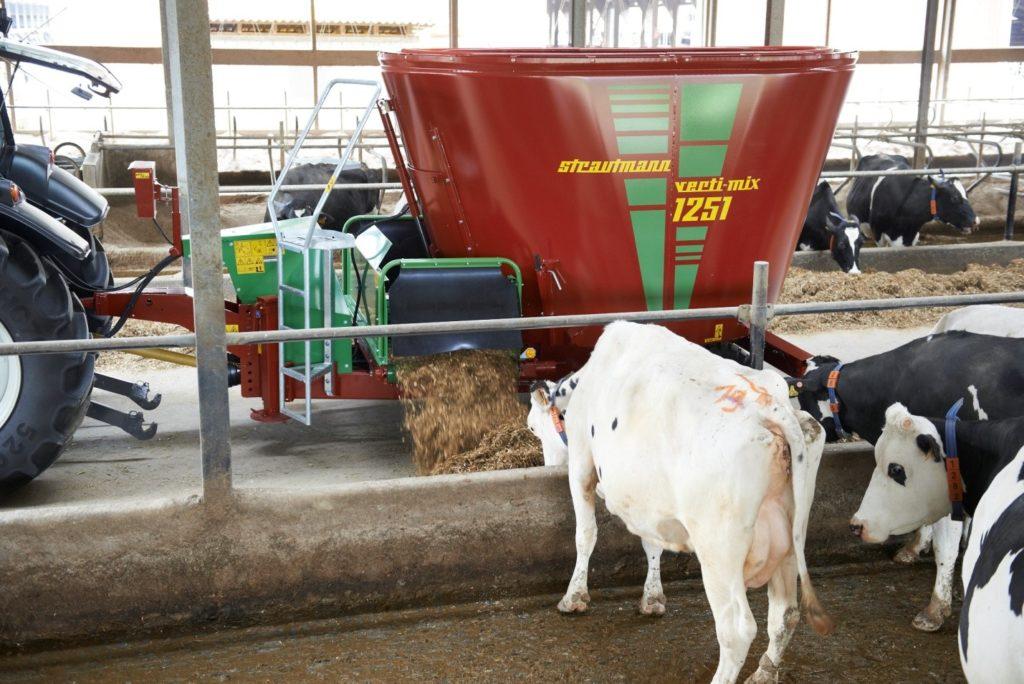
Mobile dispenser at work
Today, manufacturers of agricultural machinery are ready to offer a wide selection of various units. They differ in carrying capacity, ways of moving and distributing.
By way of movement
Feeders are divided into two groups: mobile and stationary. The mobile unit is a self-propelled machine with an electric drive. She moves independently around the farm and delivers feed to each feeder.
Stationary types of feeders are installed in the room where animals are kept. They are arranged as feeders with a conveyor. The automatic line mixes, grinds the feed and then dispenses it from the hopper.

Stationary devices are divided into the following types:
- scraper - equipped with a chain-scraper mechanism;
- tape - move using a roller tape;
- platform - feed is supplied by a conveyor;
- cable-washer - the feed mixtures are delivered to the feeders with a cable with washers fixed on it.
Stationary mechanisms are used in any type of premises where it is difficult to apply other equipment due to narrow aisles.
By distribution type
The equipment is distinguished by the type of mixture supply. Some models dispense feed from one side of the stalls, a number of mechanisms can dispense food from both sides of the feeders (single or double sided dispenser).
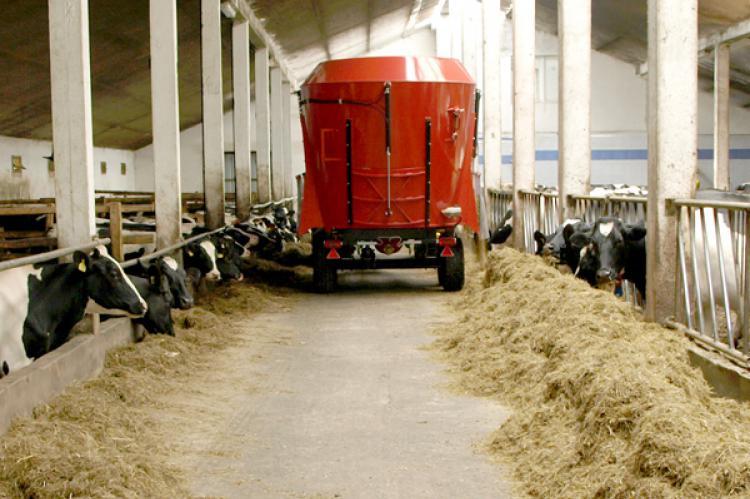
By carrying capacity
The lifting capacity determines how much mass the dispenser can lift and deliver. This classification is especially indicative for mobile mechanisms. It depends on the axles of the tractor, as well as on the carrying capacity of the chassis of the vehicles where the feed dispenser is located.
Average lifting capacity: from 1.1 to 3 tons - for single-axle mechanisms, from 3.5 to 4 tons - for vehicles with a pair of axles. You need to choose a device based on the needs of the livestock complex.
The best feed wagons for cattle farms
Drawing of mobile equipment KTU-10
When choosing, it is recommended to pay attention to the following technical characteristics and parameters of mechanisms:
- bunker capacity - it will show how much feed the dispenser is able to distribute during one loading;
- the most important characteristic is dimensions, if you do not take it into account, then it will be difficult for mobile devices to enter some rooms;
- magnetic catcher, which allows to exclude the ingress of metal parts into food;
- self-loading and electronic weighing system;
- augers affecting performance in mixing, grinding and feeding.
Before buying, you should carefully check the technical condition of the unit.
Stationary
Stationary model
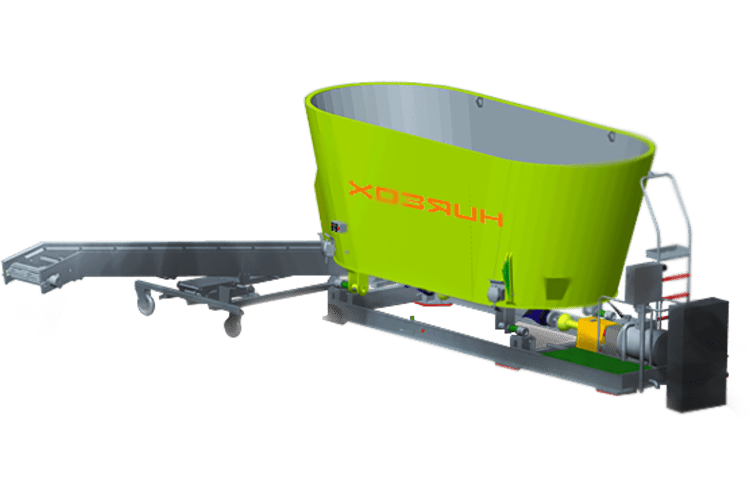
The most popular models include:
- KRS-15. This model is a horizontal open type conveyor distributor. It belongs to the scraper type. The conveyor is equipped with two distribution channels and runs along the bottom of the feeders. The device starts up with the operation of the electric motor. First, the feed is fed behind the fence, then distributed with scrapers. The drive is disconnected spontaneously when the scraper goes through a full revolution.
- TVK-80B. The technique is ideal for dry and solid forage.It is based on a tape mechanism that resembles a closed ring. It is driven by a motor. From the hopper, feed mixtures are fed into the feeders in equal shares, then the mechanism is turned off.
- RK-50. The mechanism is equipped with a conveyor belt, which is located above the feeder. The model has two options - for a livestock complex for 100 and 200 individuals. The basis of the feeder is a control unit, an inclined and transverse conveyor, and a pair of distributors. The length of the feeding facility is about 75 m, with a capacity of 3-30 tons per hour.
Comparative table of stationary models
When choosing a stationary model, it is important to take into account the productivity, the number of heads, the length of the feeding area.
| Model | Number of heads | Feeding area length | Performance | Engine power | Weight |
| KRS-15 | 180 | 40 m | 15 t / h | 5.5 kW | 1540 kg |
| TVK-80B | 65 | 74 m | 38 t / h | 5.5 kW | 3300 kg |
| RK-50 | up to 200 | 75 m | 3-30 | 9.7 kW | 5400 kg |
Mobile
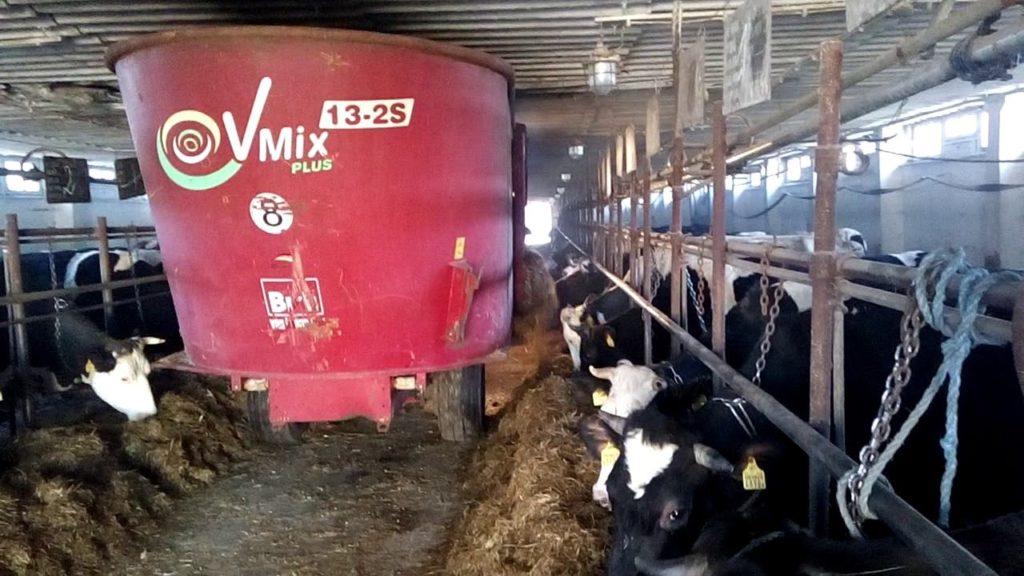
Delivery of mixtures with a mobile unit
Among the mobile units, the most interesting and functional are the following:
- KTU-10. The model of the feed dispenser deserves attention, but it should be noted right away that it cannot work in narrow rooms due to the small turning area of the equipment. The unit can be driven on a tractor trailer. It is equipped with several beaters, unloading and cross conveyor. The speed of feeding food into the feeders directly depends on the speed of the machine.
- ISRK-12. The feeder is designed for large farms and has a wide range of functions. Loading can be done in rolls without having to sort out the feed in advance. Special additives are poured into a separate window. When the machine is running, the feed is chopped up, as well as thoroughly mixed. The model is equipped with a two-stage gearbox with 4 auger rotation speeds and a remote control panel from the machine cab. An additional function is an electronic weighing system for ingredients and a memory for dozens of recipes from different components.
- RMM-5.0. This model is considered small because it is convenient to use in narrow spaces. The feeder is adapted to work with various modifications of the Belarus tractor and other equipment. Refers to multifunctional single-axis models.
The machines can be used even more efficiently, as manufacturers are more responsive to customers and can tailor models to specific conditions on the farm.

|
Model | Hopper volume | Feed rate | Performance | Power engine | Weight |
| KTU-10
| 10 m3 | 3-25 kg / m | 50 t / h | 7,5 | 2200 kg |
| ISRK-12 | 12 m3 | 15-150 kg / m | 7.8 t / h | 5,3 | 4500 kg |
| RMM-5.0 | 5 m3 | 1-16 kg / m | 3-38 t / h | 6 | 1370 kg |
Comparison Chart of Mobile Feeders
Automatic feed dispensers with mixers are very popular among farmers, which quickly deliver feed mixtures to animal feeders, having previously prepared them. For these purposes, feed mixers, which are offered to farmers by the Intermix company, are well suited. The equipment is capable of working with all types of feed for cows - grass and silage, grain crops, root crops and granulated feeds of different fractions.
The models are diverse, have different modifications, and, accordingly, the characteristics:
Terms of use
Before starting work, the technician must be checked for faults, breakdowns, and you should also make sure that the grounding and protective fences are reliable.
Before loading feed, check the machine at idle speed.
Further maintenance should include periodic lubrication, checking the condition of mechanisms and assemblies. Regardless of the dispenser model, it is important for cattle farms to regularly clean up feed residues and dirt.


